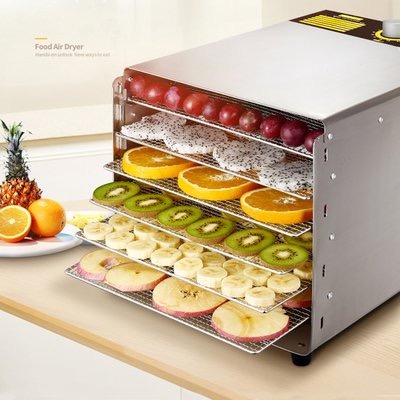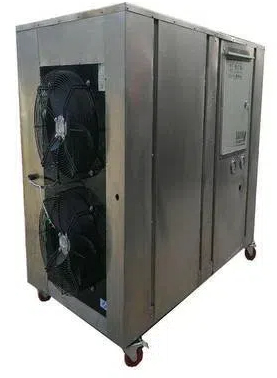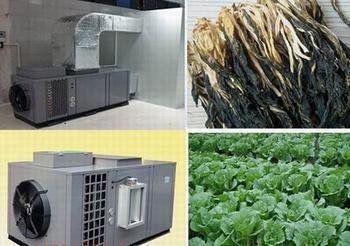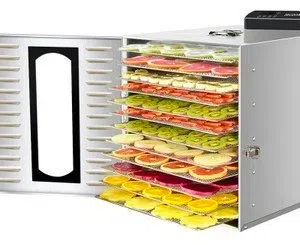
Content Menu
● Introduction
● Understanding Heat Pump Dryers
>> Benefits of Heat Pump Dryers
● The Importance of Regular Cleaning
>> Common Issues Due to Lack of Cleaning
● How Often Should You Clean Your Heat Pump Dryer?
>> Recommended Cleaning Schedule
● Step-by-Step Cleaning Guide
>> Daily Maintenance
>> Weekly Maintenance
>> Monthly Maintenance
>> Annual Maintenance
● Troubleshooting Common Problems
>> Problem 1: Dryer Not Heating
>> Problem 2: Excessive Noise During Operation
>> Problem 3: Longer Drying Times
>> Problem 4: Moisture Retention in Food Products
>> Problem 5: Error Codes Displayed
● Additional Tips for Maintaining Your Heat Pump Dryer
● Conclusion
● Frequently Asked Questions (FAQs)
>> 1. How often should I clean my heat pump dryer?
>> 2. What are the signs that my heat pump dryer needs repair?
>> 3. Can I perform repairs on my heat pump dryer myself?
>> 4. What should I do if my dryer is not heating?
>> 5. How can I improve the efficiency of my heat pump dryer?
Introduction
In the world of food processing, heat pump dryers have become an essential tool for preserving food quality while ensuring energy efficiency. These machines utilize advanced technology to remove moisture from food products, extending their shelf life and maintaining nutritional value. However, like any appliance, heat pump dryers require regular maintenance to operate effectively. One of the most critical aspects of this maintenance is cleaning. This article delves into the importance of cleaning your heat pump dryer, how often it should be done, and tips to prevent repairs.

Understanding Heat Pump Dryers
Heat pump dryers work by using a refrigeration cycle to extract moisture from food. Unlike traditional dryers that expel hot air, heat pump dryers recycle the air within the system, making them more energy-efficient. This technology not only conserves energy but also allows for lower drying temperatures, which helps preserve the quality of the food.
Benefits of Heat Pump Dryers
- Energy Efficiency: Heat pump dryers consume less energy compared to conventional drying methods.
- Quality Preservation: They maintain the nutritional value and flavor of food better than other drying methods.
- Versatility: Suitable for a wide range of products, including fruits, vegetables, and meats.
- Reduced Carbon Footprint: By utilizing less energy, heat pump dryers contribute to lower greenhouse gas emissions.
- Compact Design: Many models are designed to fit in smaller spaces without compromising performance.
The Importance of Regular Cleaning
Cleaning your heat pump dryer is crucial for several reasons:
1. Preventing Repairs: Regular cleaning helps prevent common issues that can lead to costly repairs.
2. Maintaining Efficiency: A clean dryer operates more efficiently, reducing energy consumption.
3. Extending Lifespan: Proper maintenance can significantly extend the lifespan of your equipment.
4. Ensuring Food Safety: A clean dryer minimizes the risk of contamination from mold or bacteria.
5. Improving Air Quality: Regular cleaning helps maintain better air quality in your processing facility.
Common Issues Due to Lack of Cleaning
- Clogged filters can restrict airflow, leading to overheating.
- Residue buildup can affect drying performance.
- Mold and bacteria growth can compromise food safety.
- Increased energy consumption due to inefficient operation.
How Often Should You Clean Your Heat Pump Dryer?
The frequency of cleaning your heat pump dryer depends on several factors:
- Usage Frequency: If you use your dryer daily, a more frequent cleaning schedule is necessary.
- Type of Food Processed: Certain foods may leave more residue than others; for instance, fatty or sugary foods may require more frequent cleaning.
- Manufacturer Guidelines: Always refer to the manufacturer's recommendations for specific cleaning intervals.
Recommended Cleaning Schedule
- Daily: Remove lint and clean filters after each use.
- Weekly: Wipe down surfaces and check for any buildup.
- Monthly: Deep clean the interior and exterior components.
- Annually: Schedule a professional maintenance check.
Step-by-Step Cleaning Guide
Daily Maintenance
1. Turn Off and Unplug the Dryer: Safety first!
2. Remove Lint from Filters: Clean out lint from the filter after each use to ensure optimal airflow.
3. Wipe Down Surfaces: Use a damp cloth to wipe down accessible surfaces where dust or residue may accumulate.

Weekly Maintenance
1. Inspect Filters: Check for any clogs or buildup that could affect performance.
2. Clean Exterior: Wipe down with a mild detergent and water solution to remove grease or grime.
3. Check Drainage System: Ensure there are no blockages in the drainage system that could lead to water accumulation.
Monthly Maintenance
1. Deep Clean Filters: Soak filters in warm water with detergent if necessary; rinse thoroughly before reinstalling.
2. Inspect Vents and Ducts: Clear any obstructions that may restrict airflow; this is crucial for maintaining efficiency.
3. Check Seals and Gaskets: Ensure they are intact and functioning properly; replace any damaged seals to prevent leaks.
Annual Maintenance
1. Professional Inspection: Hire a technician to perform a thorough inspection and cleaning; this ensures all components are functioning optimally.
2. Replace Worn Parts: Consider replacing any parts that show wear or damage; proactive replacement can prevent future issues.
Troubleshooting Common Problems
Even with regular cleaning, issues may still arise with heat pump dryers. Here are some common problems and their solutions:
Problem 1: Dryer Not Heating
- Cause: Clogged filters or ducts may restrict airflow.
- Solution: Clean filters regularly and check ducts for blockages; ensure that there are no obstructions in airflow paths.
Problem 2: Excessive Noise During Operation
- Cause: Loose components or foreign objects inside the dryer may cause rattling or banging sounds.
- Solution: Inspect for loose parts or debris causing noise; tighten any loose screws or bolts.
Problem 3: Longer Drying Times
- Cause: Dirty filters or insufficient airflow due to clogs can lead to extended drying times.
- Solution: Clean filters regularly and check for airflow issues; ensure that vents are clear.
Problem 4: Moisture Retention in Food Products
- Cause: Improper settings or malfunctioning sensors may prevent adequate moisture removal from products.
- Solution: Ensure settings are correct according to the type of food being dried; check sensors for proper functionality.
Problem 5: Error Codes Displayed
- Cause: Various issues related to sensors or electrical components may trigger error codes on the display panel.
- Solution: Refer to the user manual for specific error codes and troubleshooting steps; reset the machine if necessary.
Additional Tips for Maintaining Your Heat Pump Dryer
To further enhance the performance and longevity of your heat pump dryer, consider these additional tips:
1. Use Proper Settings:
- Always select the appropriate drying settings based on the type of food being processed. Using incorrect settings can lead to inefficient drying and potential damage.
2. Monitor Temperature Levels:
- Keep an eye on temperature levels during operation. If you notice fluctuations outside normal ranges, it may indicate a need for servicing.
3. Keep Surrounding Area Clean:
- Maintain cleanliness around your dryer unit as dust and debris can enter through vents and affect performance.
4. Regularly Check Electrical Connections:
- Inspect electrical connections periodically for signs of wear or damage; ensure all connections are secure.
5. Educate Staff on Proper Use and Maintenance:
- Train staff members on how to operate the dryer correctly and emphasize the importance of regular maintenance practices.
Conclusion
Regular cleaning of your heat pump dryer is essential for maintaining its efficiency and preventing costly repairs. By adhering to a structured cleaning schedule and following proper maintenance practices, you can extend the lifespan of your equipment while ensuring that your food products are dried safely and effectively. Remember that if you encounter persistent issues despite regular maintenance, it may be time to consult with a professional technician specializing in heat pump dryer repair.

Frequently Asked Questions (FAQs)
1. How often should I clean my heat pump dryer?
You should clean your heat pump dryer daily by removing lint from filters, weekly by wiping down surfaces, monthly by deep cleaning components, and annually by scheduling professional maintenance.
2. What are the signs that my heat pump dryer needs repair?
Common signs include longer drying times, unusual noises during operation, moisture retention in dried products, error codes displayed on the control panel, and inconsistent heating performance.
3. Can I perform repairs on my heat pump dryer myself?
While some minor issues can be addressed through DIY methods, it is advisable to consult a professional technician for complex repairs to ensure safety and proper functioning.
4. What should I do if my dryer is not heating?
Check for clogged filters or ducts that may be restricting airflow; clean them thoroughly before attempting further troubleshooting.
5. How can I improve the efficiency of my heat pump dryer?
Regularly clean filters and vents, ensure proper settings are used for different food types, keep surrounding areas clean from dust accumulation, monitor temperature levels during operation, and schedule annual professional inspections to maintain optimal performance.
By following these guidelines and maintaining a consistent cleaning routine, you will not only enhance the performance of your heat pump dryer but also ensure that it operates efficiently throughout its lifespan while minimizing repair needs related to neglect or improper care.












